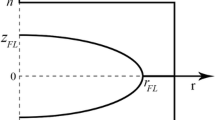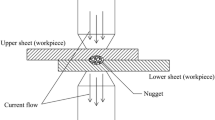Abstract
In this study, a finite element model was developed based on the thermal contact conductance for predicting the nugget formation during the welding process in aluminum alloy 6061-T6. Since the strength of spot welded joints is completely dependent on nugget dimensions, an axisymmetric coupled structural–thermal–electrical finite element model was built and utilized to predict the nugget size. The thermal contact conductance, which is considered as a function of temperature and surface roughness, was applied in the contact area between electrode–workpiece and workpiece–workpiece. The results were validated by the data obtained from the nugget experimental measurement tests on the aluminum alloy and the previous study on steel. The obtained data from finite element model enjoys good agreement with the experimental nugget measurement tests. The results indicate that in the modeling of aluminum alloys spot welding, the thermal contact conductance has a major role in nugget enlargement during the welding process and cannot be ignored. In addition, it was shown that by increasing the welding heat input to the nugget zone, the contact resistance at the interfaces (electrode–sheet and sheet–sheet) will be decreased. As a result of that, the height of the nugget increases with a higher rate comparing to its diameter. Furthermore, in this study, the effects of spot welding parameters such as the welding current and the welding time are investigated on nugget dimensions.
Similar content being viewed by others
References
Hayat F, Sevim I (2012) The effect of welding parameters on fracture toughness of resistance spot-welded galvanized DP600 automotive steel sheets. Int J Adv Manuf Technol 58:1043–1050
Yang HG, Lai XM, Zhang YS, Chen GL (2010) Investigations on the weldability of high-strength steels sheet to cylindrical tube single-sided spot welding. Int J Adv Manuf Technol 49:513–518
El-Banna M, Filev D, Chinnam RB (2008) Online qualitative nugget classification by using a linear vector quantization neural network for resistance spot welding. Int J Adv Manuf Technol 36:237–248
Sun X, Stephens EV, Khaleel MA (2008) Effect of fusion zone size and failure mode on peak load and energy absorption of advanced high strength steel spot welds under lap shear loading conditions. Eng Fail Anal 15:356–367
Gould JE (1987) Examination of nugget development during spot welding, using both experimental and analytical techniques. Weld J 66:1–10
Tsai CL, Jammal OA, Papritan JC (1992) Modeling of the resistance spot welding nugget growth. Weld J 71:47–54
Gupta OP, De A (1998) An improved numerical modeling for resistance spot welding process and its experimental verification. J Manuf Sci Eng 120:246–251
Popkovskii VA, Berezienko VP (1998) Effect of resistance spot welding conditions on the distribution of residual stresses. Weld J 12:1058–1061
Khan JA, Xu L, Chao YJ, Broach K (2000) Numerical simulation of resistance spot welding process. Numer Heat Tr A-APPL 37:425–446
American Welding Society (2003) Recommended practices for resistance welding. AWS C1.1M/C1.1:2000 New York
Xu L, Khan JA (1999) Nugget growth model for aluminum alloys during resistance spot welding. Weld J 78:367–372
Sun X, Dong P (2000) Analysis of aluminum resistance spot welding process using coupled finite element procedures. Weld J 79:215–221
De A, Thaddeus MP, Dorn L (2003) Numerical modeling of resistance spot welding of aluminum alloy. ISI J Int 43:238–244
Cheng F, Zhang J, Shengsun HU, Shan P (2011) Numerical simulation on nugget formation and evolution in spot welding of aluminum alloy. Trans Tianjin Univ 17:28–32
Tsai CL, Dai WL, Dickinson DW, Papritan JC (1991) Analysis and development of real-time control methodology in resistance spot welding. Weld J 69:339–351
American National Standard (1997) Weld button criteria, recommended practice for test methods for evaluating the resistance spot welding behavior of automotive sheet steel metal. American National Standard. ANSI/AWS/SAE, New York
Long X, Khanna SK (2005) Residual stresses in spot welded new generation aluminium alloys part B—finite element simulation of residual stresses in spot weld in 5754 aluminium alloy. Sci Technol Weld Joi 10:88–94
Cha BW, Na SJ (2003) A study on the relationship between welding conditions and residual stress of resistance spot welded 304-type stainless steels. J Manuf Syst 22:181–189
Babu SS, Santella ML, Feng Z, Riemerand BW, Cohron JW (2001) Empirical model of effects of pressure and temperature on electrical contact resistance of metals. Sci Technol Weld Joi 6:126–132
Rohsenow WM, Hartnett JR, Cho YI (1998) Handbook of heat transfer, 3rd edn. McGraw-Hill, New York
Chao Y, Qi X (1998) Thermal and thermo-mechanical modeling of friction stir welding of aluminium alloy 6061-T6. J Mater Process Technol 7:215–233
Hirsch J, Skrotzki B, Gottstein G (2008) Aluminum alloys: their physical and mechanical properties. Wiley, New York
Author information
Authors and Affiliations
Corresponding author
Rights and permissions
About this article
Cite this article
Karimi, M.R., Sedighi, M. & Afshari, D. Thermal contact conductance effect in modeling of resistance spot welding process of aluminum alloy 6061-T6. Int J Adv Manuf Technol 77, 885–895 (2015). https://doi.org/10.1007/s00170-014-6492-1
Received:
Accepted:
Published:
Issue Date:
DOI: https://doi.org/10.1007/s00170-014-6492-1




